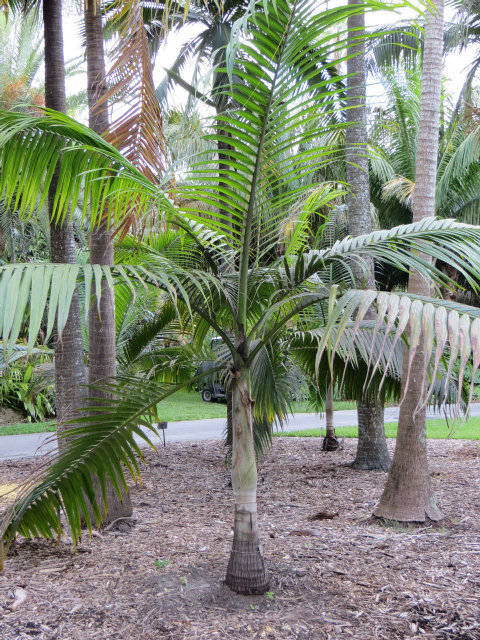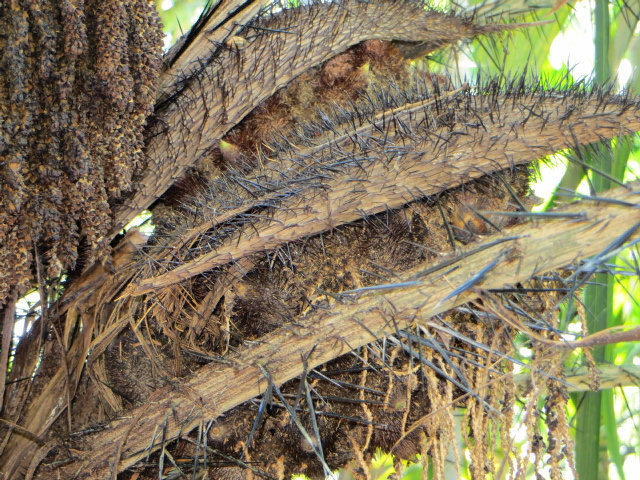Palms and their extreme ways of adapting

As published in The Miami Herald
Summer in Miami is not for the faint of heart. If the humidity does not make you weary, the mosquitoes definitely will. South Florida natives are tough but through air conditioning, bug spray and sunscreen, we have adapted to living in a sometimes harsh sub-tropical climate.
While we have changed our environment, palms adapt to stressful conditions by reacting to the environment and changing their growth habits.
Palms live on every continent, except Antarctica, and in every type of habitat. The ability to react to their environment, undergoing extreme adaptations to their growth, allows palm species to succeed where other plants cannot. More severe stresses induce more extreme adaptations and the following palms have adapted to different environmental stresses, resulting in some bizarre features.
 |
| This young hurricane palm is striking in the landscape and an expert at surviving our southern Florida storms. |
Dictyosperma album is commonly called the princess palm in the horticulture trade. It is also known as the hurricane palm and it comes by its name honestly.
Native to the Mascarene Islands, this palm is constantly badgered by heavy winds and hurricanes. Cumbersome palm leaves can be the demise of a healthy tree as they easily catch the wind and cause the trunk to snap in half. The hurricane palm has adapted to superstorms by dropping its leaves when it first experiences heavy winds. By the time the storm intensifies and would catch the leaves, snapping the trunk, the leaves have long dropped. The trunk is now a solitary pole that can move with the wind without being injured. and the palm survives the storm.
While other plants can’t handle this extreme weather condition, this palm has adapted its growing mechanism and it flourishes. Southern Florida, a hot spot for tropical storms, is a great place to plant a hurricane palm (and even more so if you are a Canes fan!). The trick to growing this is proper placement. Hurricane palms prefer light shade to full sun and well-drained soil with lots of water.
Another palm that overcame a large environmental stress is the stilt palm, Socratea exorrhiza. These incredible palms grow in the “hole” of Amazonia in swampy, unstable ground. Its stilt roots give it extra support and allow it to stay stable in mucky soil. The stilt roots are quite stately and popular with palm enthusiasts and collectors.
Tough to grow in southern Florida, the stilt palm requires year-round humidity and heat, deep shade and acidic soils, conditions we don’t have.
But not all adaptations deal with habitat constraints such as wind and soil type. Aiphanes minima, macaw palms, overcome a different kind of stress: predation.
 |
| Unlike most spined palms, leaves on the Aiphanes minima have spines on both the topside and underside. |
Many palms are armored with spines for protection on the petioles and/or trunk. But this palm doesn’t have spines like most other palms; it has spines on the top and bottom surface of the leaf, for even more protection. This ensures that animals that normally would feast on leaves and other parts stay far away.
The macaw palm is native to rainforests of some Caribbean islands. If it is planted in a warm and sheltered part of your yard, cultivation is possible.
Another palm with extreme spines is the choco palm, native to rainforests of Mexico and Central America. Astrocaryum mexicanum is mostly interested in protecting its precious fruit, its source of reproduction. Spines on the trunk and leaves are paltry compared to the ferocity of the spines on the fruit. Not only is its fruit armored, the pod that encloses the flowers also has spines. The extreme investment in fruit protection is clearly successful in keeping predators from ingesting the seed.
 |
| The spines on the leaves and trunk of the choco palm are futile compared to the dense and intense spines covering the fruit. |
Cultivation of the choco palm is possible in southern Florida — it’s the most cold-hardy Astrocaryum species. Extra caution is required with any spined palms, especially for young children and pets.
The conditions experienced by these palms are undoubtedly extreme — deathly winds, sinking soils and voracious predation. But these palms metamorphosed in order to be the best adapted species. Since palms cannot change their environment as we can, they react to their environment, resulting in beautiful and extreme adaptations.
